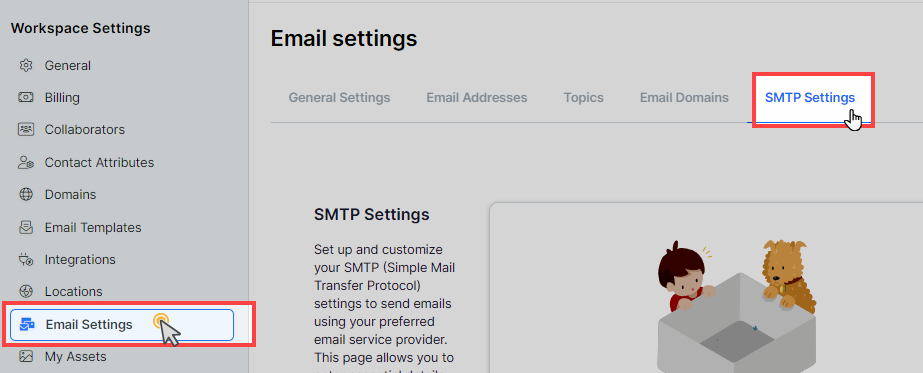To send emails through ClickFunnels using an external email service provider like SendGrid or Mailgun, you need to connect an SMTP (Simple Mail Transfer Protocol) service. Once connected, all emails from the associated email domain will be routed through the SMTP server instead of ClickFunnels’ email server. This article walks you through the steps to set up an SMTP connection in ClickFunnels.

Requirements
An active ClickFunnels account.
A verified domain or sub-domain in ClickFunnels, including both domain and email DNS records, that you want to associate with your SMTP service.
SMTP service credentials (e.g., username, password, or API key) from your chosen provider.
Sending emails from ClickFunnels, with or without using an SMTP, is designed solely for outgoing emails. ClickFunnels does not provide a mailbox for receiving replies. If your audience replies to an email sent from a custom email address in ClickFunnels, the response will not be received within ClickFunnels.
To handle replies, you will need to set up a mailbox for your custom email address with an external service, such as Google Workspace, Microsoft 365, Zoho Mail, etc.
Why Connect an SMTP?
Connecting an SMTP allows you to use external email services like SendGrid, Mailgun, etc., for sending marketing and transactional emails. You can connect your email domain (root domain or sub-domain) to an SMTP service. Once set up, all emails sent from ClickFunnels will be routed through the SMTP server, ensuring proper email delivery and tracking.
Steps to Connect an SMTP in ClickFunnels
Step 1 - Add a New SMTP
In your ClickFunnels account, go to Workspace Settings and select Email Settings from the left-side navigation.
Click on SMTP Settings.

Click the Add SMTP Setting button to begin configuring a new SMTP connection.
Step 2 - Enter SMTP Details
In the new SMTP settings pop-up, fill in the following fields:

Nickname: Enter a name for this SMTP configuration (for internal use).
Email Domain: Select the domain associated with this SMTP configuration.
Server: Choose your SMTP provider (SendGrid, Mailgun, or Other). If you select “Other” as the SMTP provider, you will need to provide the Custom SMTP Server Address. This is the server address used by your SMTP provider for sending emails (e.g., smtp.yourprovider.com). You can obtain this information from your SMTP provider’s documentation or support team.
You can connect any other SMTP provider, but tracking capabilities (e.g., delivery and bounce statistics) will be limited.
Port: Enter
587or enter the SMTP port provided by your SMTP service.Username: Enter the username provided by your SMTP service. For some providers, this may be your email address. If you’re using SendGrid, enter text
apikeyin this field.Password: Enter the password or API key provided by your SMTP service. For SendGrid, this will be your API key.
Step 3 - Add Webhook URL for Tracking Events
After entering your SMTP details, you will be prompted to add a Webhook URL. This webhook is necessary for tracking the performance of your emails, such as delivery, opens, clicks, and bounces. The provided webhook URL needs to be added to your SMTP provider.
Copy the Webhook URL provided by ClickFunnels.
Go to your SMTP provider’s settings and create a new webhook.
Paste the copied webhook URL into your SMTP provider’s webhook field.
Once you’ve added the webhook, check the box that says Webhook URL added in ClickFunnels to confirm the integration.

After adding the webhook and completing the SMTP details, click Update SMTP setting. ClickFunnels will verify the connection and update the SMTP status.
How ClickFunnels Utilizes an SMTP for Email Sending
Once your SMTP is successfully connected to your ClickFunnels workspace, the system will display the verified status for your associated email domain.
Any email address created within your workspace, linked to this domain, will automatically use the SMTP for email delivery when sending broadcasts or emails within workflows. ClickFunnels dynamically makes this decision based on the connected SMTP and the selected email address.
Example:
For instance, you want to use SendGrid as SMTP. You have verified the domain www.yourdomain.com in your ClickFunnels workspace and set up an email address like support@yourdomain.com. After verifying the domain and DNS records both in ClickFunnels and SendGrid, when you’re ready to send a broadcast or trigger an email step in a workflow, you will choose the email address you wish to send from. If you select support@yourdomain.com, ClickFunnels will automatically route the email through SendGrid’s SMTP, as the email address is associated with the verified domain connected to SendGrid. If SendGrid was not connected, ClickFunnels would use default internal mail server. If SendGrid were not connected, ClickFunnels would default to its internal mail server for email sending.
Troubleshooting
If you’re having trouble setting up an SMTP, check the following:
Incorrect SMTP Credentials: Double-check your SMTP username and password.
Firewall Issues: Ensure your SMTP provider is not blocking access to ClickFunnels servers.
Propagation Time: It may take some time for the SMTP connection to propagate fully.